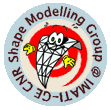
Welcome
to the
Classification of Watertight Models Track
of SHape Retrieval Contest 2008


|
Welcome
|

|
This track addresses 3D shape classification, meant as the process of assigning an unknown 3D model to one of the classes of a given set of models. The latter will be pre-classified according to semantic criteria, such as functionality (e.g., "objects for drinking") or presence of characteristic shape features (e.g., "parts with sharp features"). Different levels of categorization will be taken into account, ranging from an entry, coarse level (e.g., grouping objects into "furniture" and "four limbs animals") to finer levels (e.g., "chairs", "sofas", "dogs", and "cats"). The algorithms proposed by the track competitors should be able to capture the geometric and semantic meaning stored in each category. This can be achieved through a learning phase, as specified below.
Track Description:
First off, the participants will be provided with a small Training Set (TS), pre-classified as described before, that can possibly be used for training the algorithms in a short-term learning phase. Then, a larger, pre-classified Data Set (DS) will be released, along with a Query Set (QS) of unknown objects. For each query in QS, the aim is to establish a ranking of memberships in the DS classes, where the class ranked first represents the category that most reasonably contains the query. Hence, the participants will be asked to return, for each query, a list of values corresponding to the probability for the query to belong to each of the DS classes. All models in TS, DS and QS will be watertight models. The taxonomy used for classifying the TS, DS and QS will be innerly coherent and established a priori. The performance of the algorithms will be evaluated using standard parameters (e.g., the classification rate).
Instructions for competitors:
Each participant is requested to:
This year the summary papers will be included in the SMI 2008 proceedings, so we require the participants to respect the following styling rules:
Within this track, a model is considered "watertight" if it is represented by seamless surfaces (without defective holes or gaps).